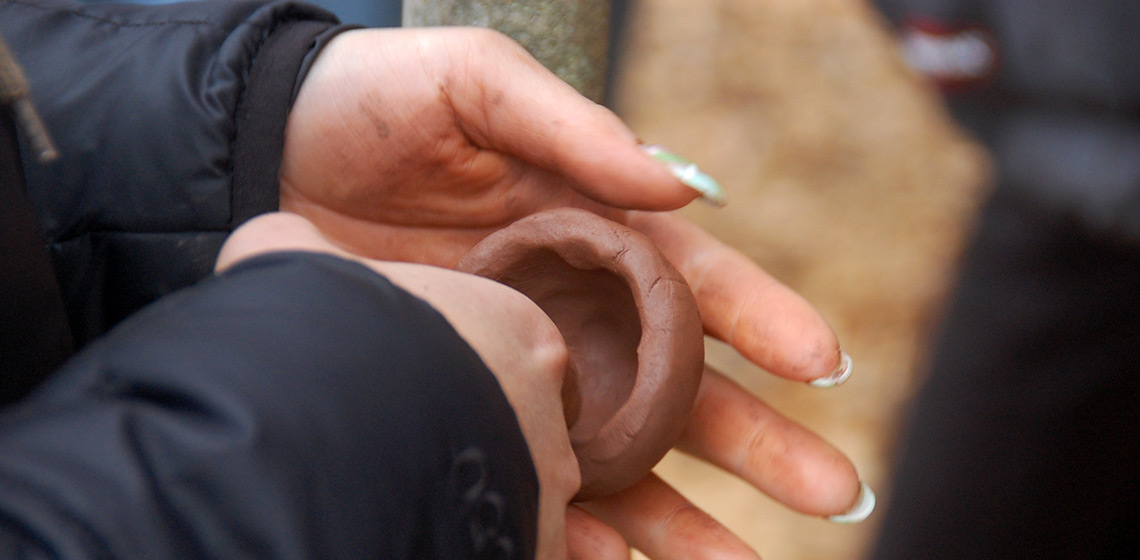The content is published under a Creative Commons Attribution Non-Commercial 4.0 License.
Unreviewed Mixed Matters Article:
Pottery at the Scottish Crannog Centre

The Scottish Crannog Centre, an open-air museum on Loch Tay in Highland Perthshire, has been able to do some really meaningful, powerful work over the past 12 months focusing on the power of prehistoric pottery! Supported by the Esmee Fairbairn Collections Fund and the Headley Trustand Art Fund, the project has led to new relationships, a new strategic partner for the organisation and all-round learning about the collection and best practice in meaningful community engagement.
Pottery is an extremely powerful tool for working with groups that may not normally access museum services. Clay and ceramic is incredibly resilient, it is not just domestic, its historically everywhere. From forging and blacksmithing we know it can withstand 1000 degrees of heat and it survives!! The incredible experience of putting your finger into a fingerprint left by someone over 2500 years ago, creates intangible, emotional experiences by physically connecting to the past. It reinforces the fact that everyone can contribute, to make their mark on history, aiming to empower individuals who have had their power taken away by trauma or society. We aim to create an organisation where there are a thousand fingerprints and a thousand voices involved in all we do.
Using a previously unexplored collection, never before seen by the public, we have worked with community groups of domestic abuse survivors (Perth Women’s Aid, Rape and Sexual Assault Centre. OWLS), their families (CEDAR group and CYP group from PWA), children with additional support needs (Barnados, Perth and Dundee branches), and the Maryhill Integration Network (Refugee integration group from Glasgow). This will form the basis of a new exhibition and interpretation in the museum, co-created between the museum and the audiences we serve. We feel that great interpretation using an archaeology collection should enable the objects to tell their many stories to many diverse audiences, and for people to feel part of the story, able to contribute to it, and take something away when they leave.
Embracing the everyday nature of Pottery, it is everywhere, everyone uses it, we used the idea of a favourite mug as part of the community engagement within the project, that imbues the user with a sense of warmth, coming together, sharing, putting the kettle on, in a safe and secure place. It combines therapeutic work with history, providing things to do, to feel good about, bringing joy through making and physical work, distracting from imminent situations (such as trauma), and improving mental well-being.
To make sure that we were able to work with people in the best way for them, we have hosted in-reach sessions to the museum in a variety of different forms, both on-site at the museum, off-site at service provider offices or halls, and online, to help all groups feel part of the Crannog Community. We established close working relationships with all service providers before in-reach sessions, working with organisations to make sure we are delivering what they need from us; putting in a lot of time planning before in-person work, by exploring individual participants interests as well as needs. As a result we have had incredible feedback from all groups and their organisations.
Plans for the future are now being made. The museum is going through a major capital development to build a new museum, including an Iron Age roundhouse, village and Crannog. Our community partners from this project will be helping to build these structures with us, and developing interpretation on site. We are establishing work placements and paid workshops with service users, to support people returning to work. This work is not limited to the timescales of this project, it is developing and sustaining relationships that are already reaching far beyond; it is now core to what we do here at the museum, and is deepening our understanding of the collection by having a 1000 fingerprints and 1000 voices over all we do.
Country
- United Kingdom

